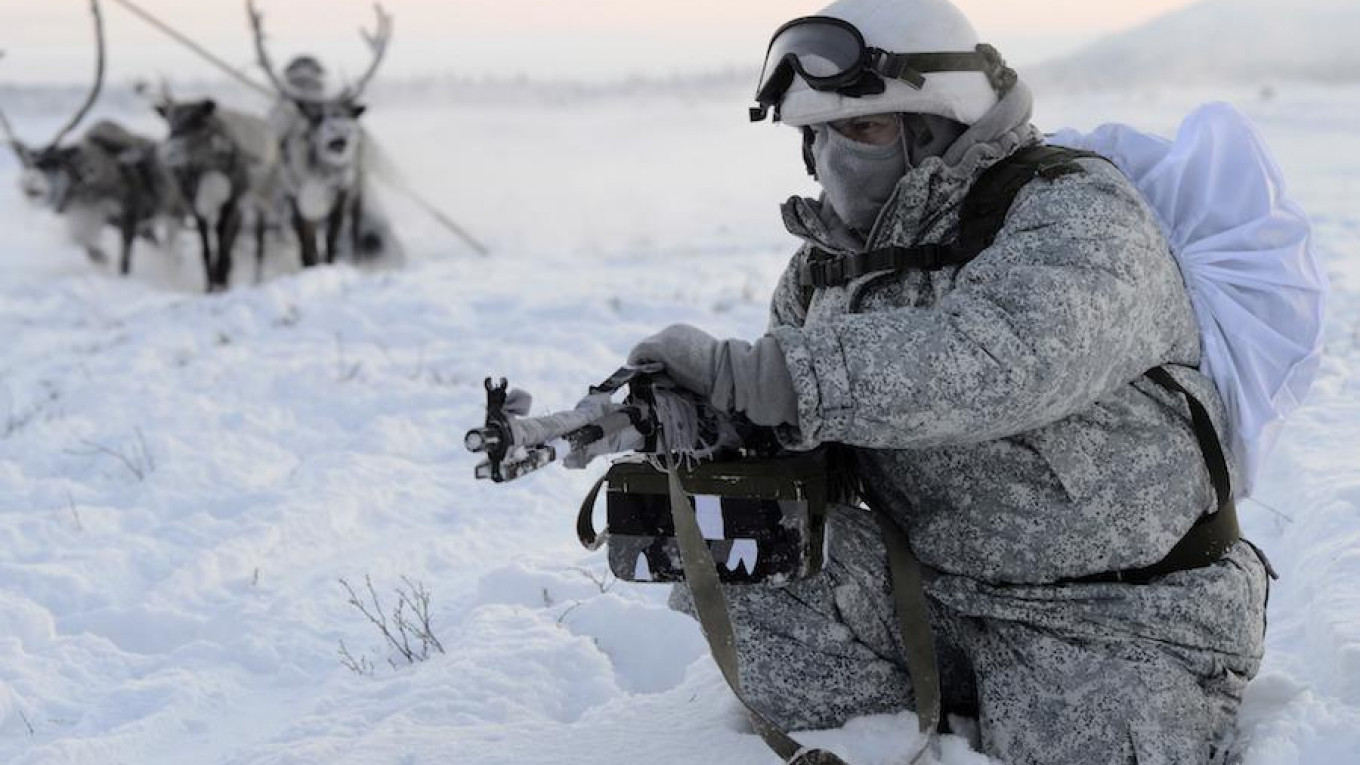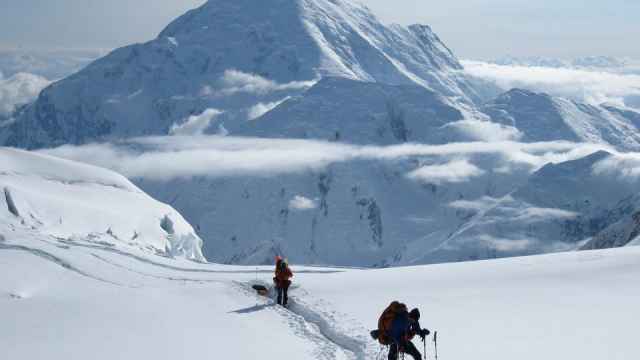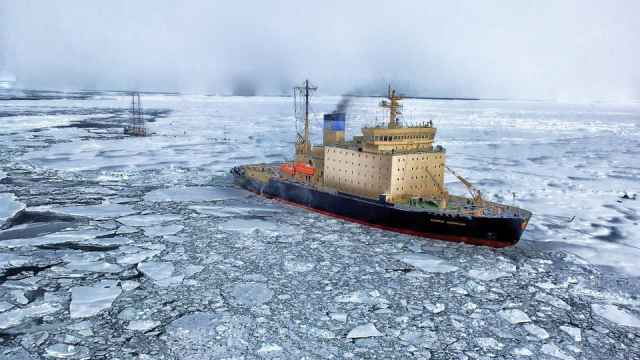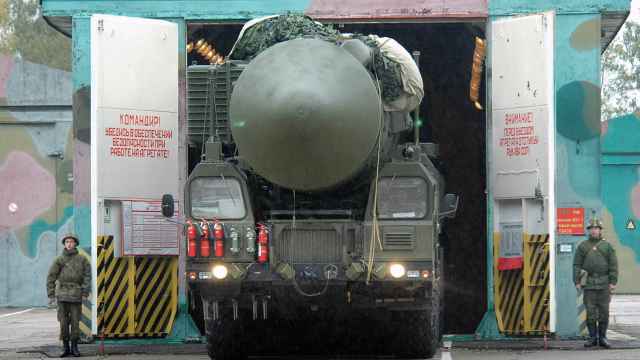On May 9, Muscovites gathered on Red Square for an annual tradition: the Victory Day military parade.
Formally, the parade marks the Soviet Union’s triumph over Nazi Germany in World War II. Informally, it gives the Kremlin a chance to send its latest tanks and missiles rolling down the street and show off its resurgent military might.
This year, the Kremlin had a surprise up its sleeve: For the first time ever, it deployed to Red Square the Tor and Pantsir air defense systems, decked out in sharp white and gray Arctic camouflage.
The appearance of Arctic forces on Victory Day underscores one of the military’s most impressive and misunderstood rearmament efforts: Since at least 2011, the Defense Ministry has worked at a breakneck pace to reopen old defensive installations on the Arctic frontier and reassert its armed presence there.
But the size and scale of the Kremlin’s Arctic build-up has some of its regional neighbors worried.
“They are concerned that this series of steps by Russia may go beyond defense and portend offensive intentions,” says Kenneth Yalowitz, an Arctic analyst who was formerly U.S. Ambassador to Belarus and Georgia.
Return to the north
If war were to break out with Russia tomorrow, the United States would have just one solitary heavy icebreaker — the 50-year-old Polar Star — to clear the way for its warships. Meanwhile, across the Arctic Sea, is a Russian icebreaker fleet of some 40 ships. Several are nuclear-powered, giving them incredible range and endurance — and more are on the way.
Russia has already put the U.S. in “checkmate,” Admiral Paul Zukunft, U.S. Coast Guard commandant, said earlier this month during a panel discussion in Washington. It’s a reality, he admitted, that keeps him awake at night.
As global warming decimates the polar ice caps, northern countries (and even non-Arctic states) are increasingly eyeing the region for economic opportunities. Climate change, many believe, promises new openings for shipping, resource extraction and even tourism in the far north. In these conditions, Russia’s Arctic build-up looks formidable.
But many Arctic observers doubt the situation is as dire as Zukunft believes. Moscow’s militarization of the polar north is far from a simple or straightforward development. Geography, demographics and Cold War history predispose Russia to military engagement in the region.
The Russian Arctic coastline is four times longer than the United States’ Alaskan frontier. Half of the Arctic’s population lives in Russia. And Russia’s official Arctic Zone—which does not even include all its Arctic territory—produces more than 5 percent of the country’s GDP.
“For comparison, Alaska contributes less than one percent of U.S. GDP," says Andrei Zagorsky, a scholar at Moscow's Institute of World Economy and International Relations and an expert on the Arctic.
As an enormous land power, Russia also faces a practical problem: The vast majority of its coastline is located in a region covered in ice for most of the year. Russia’s largest and best equipped naval force, the Northern Fleet, is designed for engagements in the Atlantic, but geography forces it to be based in the frigid northern port of Murmansk.
History plays an important role in Russia’s advantageous Arctic footing, too. Over the course of the 20th Century, the Soviet Union developed and maintained an imposing Arctic presence, establishing air bases, radar stations and anti-air batteries to defend its northern coastline during the Cold War.
Although many of those bases atrophied in the wake of the Soviet collapse, Russia has since found new reasons to focus on the Arctic. The Russian economy is heavily dependent on natural resource extraction. With production in older oil and gas fields declining, the Arctic has become the new frontier for extraction.
As a result, Moscow began reasserting its military presence and its control over territory in the Arctic. The country has reopened old Soviet bases and constructed new ones. In 2014, Russian President Vladimir Putin announced the creation of the Northern Joint Strategic Command, a Murmansk-based combined command to coordinate every military unit in the Arctic theater.
Russia currently plans to reestablish 13 air bases and ten radar stations and establish air, surface, and underwater monitoring systems. The armed forces will also deploy anti-aircraft and anti-submarine defense forces on these bases. Additionally, Russia will open 20 border outposts and ten integrated emergency rescue centers in the Arctic.
This makes Russia the only country with significant military forces permanently deployed to the Arctic. But the reasons for this are complicated and, at times, peripheral to Arctic security concerns.
The Northern Fleet includes strategic submarines with nuclear ballistic missiles, perhaps the single most important branch of Russia’s national defense. “The main task of the Northern Fleet’s surface ships is to ensure the survival of the ballistic missile submarines in the event of a nuclear war,” Zogorsky says. Even so, the surface fleet is designed for operation in the Atlantic, not the Arctic. And not a single warship is under construction for Arctic war.
Beyond this, there are climatic concerns: The northwestern Kola Peninsula is virtually Russia’s only convenient outlet to the open ocean. The water is deep and doesn’t freeze in the winter.
“Other Arctic countries have more convenient and free access to the ocean, and so they don’t have to keep their fleet up north,” Zagorsky adds.
No conflict
On May 10, Russian Foreign Minister Sergei Lavrov came to Fairbanks, Alaska to take part in a ministerial meeting of the Arctic Council. The next day he spoke before the assembled dignitaries and declared that “there is no potential for any kind of conflict” in the Arctic.
On the surface, that statement seems to contradict Russia’s military build-up in the region. But military observers suggest the likelihood of real conflict is low.
“Individual incidents are more likely—for example, the collision of two submarines,” says Andrei Frolov, editor-in-chief of the Moscow Defense Brief magazine. But he doubts this would lead to war.
There are few other immediate reasons for conflict. A 1990 agreement demarcates maritime borders, which are not disputed. And most of the Arctic’s natural resources are located in countries’ coastal shelf zones, where no one disputes the sovereign rights of the states. Russia has applied to the UN to legally extend its continental shelf in the Arctic —a move the U.S. disagrees with—but the issue hardly appears combustible.
What’s more, the Arctic countries take part in the Arctic Council, which provides a platform for dialogue on economic development, environmental protection, and other regional issues. The Arctic Coast Guard Forum also promotes regional cooperation on maritime safety and search and rescue issues.
Still, Ambassador Yalowitz says there are reasons for concern. The lack of transparency in Russia’s Arctic build-up is raising other Arctic states’ concerns that the militarization is not defensive.
Additionally, the deterioration of U.S.-Russian ties in the last three years has taken its toll: The two countries’ direct military-to-military contacts on the Arctic have been suspended. Given the risk of “unintended consequences from a military accident” in the region, resuming these contacts would be wise, Yalowitz told The Moscow Times in an email.
In the meantime, Yalowitz argues that the goal for the United States and Russia in the region is a limited one:
“They need to prevent broader geopolitical tensions from spilling into the Arctic” and stopping “the international cooperation necessary to deal with the challenge of climate change in the north.”
A Message from The Moscow Times:
Dear readers,
We are facing unprecedented challenges. Russia's Prosecutor General's Office has designated The Moscow Times as an "undesirable" organization, criminalizing our work and putting our staff at risk of prosecution. This follows our earlier unjust labeling as a "foreign agent."
These actions are direct attempts to silence independent journalism in Russia. The authorities claim our work "discredits the decisions of the Russian leadership." We see things differently: we strive to provide accurate, unbiased reporting on Russia.
We, the journalists of The Moscow Times, refuse to be silenced. But to continue our work, we need your help.
Your support, no matter how small, makes a world of difference. If you can, please support us monthly starting from just $2. It's quick to set up, and every contribution makes a significant impact.
By supporting The Moscow Times, you're defending open, independent journalism in the face of repression. Thank you for standing with us.
Remind me later.






